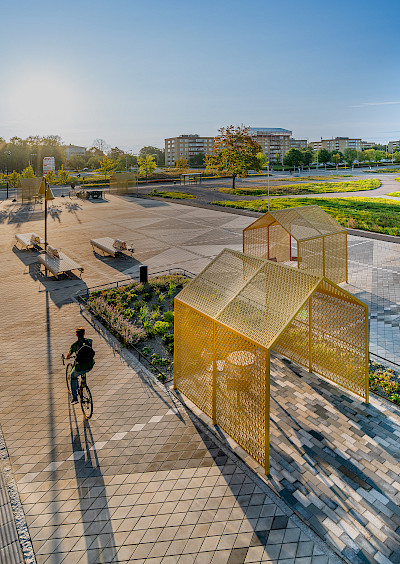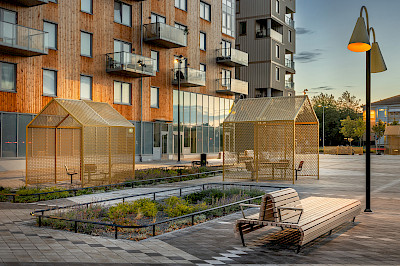Client: City of Uppsala
Landscape architect: Tengbom
Designer: Tengbom, Broberg & Ridderstråle, AJ Landskap
Anders Diös Square in Sala backe is a new public space in Uppsala that links the districts of Årsta and Sala backe. The square is part of a larger urban development project, where a former power line corridor has been transformed into a vibrant urban environment. Beneath the surface, large stormwater tanks make tree planting impossible—yet the need for shade, rest and spatial definition remains. As a response, the idea of a pavilion emerged.


The result is a site-specific composition of Parco, Riddarholmen, and the Sala backe Pavilion and Fence — design elements that offer a sense of human scale and create sheltered places to pause, wait or rest. The pavilion is a freestanding steel structure with perforated walls and roof that filters light and evokes the dappled shade of trees. Its stylised leaf motif echoes the design language of Sweden’s Folkhem era, while the house-shaped silhouette nods to the mid-century period when master builder Anders Diös helped shape many of Uppsala’s residential neighbourhoods. Diös was one of Uppsala’s most influential developers during the 20th century, leaving a lasting legacy by combining functional housing with the era’s social ideals. The pavilion’s warm brass-toned finish further enhances its connection to 1950s aesthetics and creates a rich contrast to the otherwise muted tones of the square.
An illusion of greenery that creates tranquility — a place where one can be seen, without being disturbed.
The Sala backe Pavilion is both an architectural jewel and sculptural focal point. But more importantly, it is part of a strategic effort to create a sense of security and comfort in places where trees cannot grow. An illusion of greenery that creates tranquillity — a place where one can be seen, without being disturbed.


With its distinctive character, Sala backe Pavilion acts as a placemaking element in the urban landscape, a small landmark that invites rest, presence and brief pauses.
The site is also furnished with Parco, a generous and refined furniture series with gently curved forms that provide both comfort and visual lightness, and the Riddarholmen bench, originally developed in collaboration with AJ Landskap and the National Property Board of Sweden. It is crafted from oak grown on Visingsö Island, planted in the 1800s.
The pavilion was designed by Linnea Bohlin, Alice Johansson, Åsa Hellström, and Sofia Sandqvist, who was responsible for the overall design concept.

